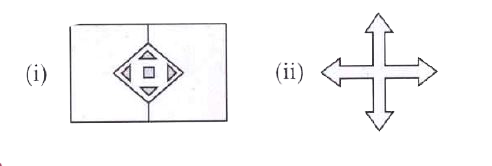How many lines of symmetry does the above figure have ?
A
In Fig. (iv) is the largest
B
In Fig. (iii)is the least
C
Fig. (ii) is same as Fig. (iii) but is smaller than Fig. (iv)
D
Is the same for all the figures
Video Solution
Text Solution
The correct Answer is:D
Gauss law of electrostatics state that the total of the electric flux out of a closed surface is equal to the charge enclosed decided by the permittivity i.e.,
Q electric =qε0
Thus, electric flux through a surface doesn’t depend on the shape, size or area of a surface but it depends on the number of charges enclosed by the surface.
So, in this question, all the figures have same electric flux as all of them have single positive charge.
|
Updated on:21/07/2023
Topper's Solved these Questions
- BOOK - ERRORLESSCHAPTER - ELECTROSTATICSEXERCISE - NCERT BASED QUESTIONS (Capacitance)59videos
ELECTROSTATICS
- BOOK - ERRORLESSCHAPTER - ELECTROSTATICSEXERCISE - NCERT BASED QUESTIONS (Grouping of Capacitors)58videos
ELECTROSTATICS
- BOOK - ERRORLESSCHAPTER - ELECTROSTATICSEXERCISE - NCERT BASED QUESTIONS (Electric Dipole)21videos
ELECTROSTATICS
- BOOK - ERRORLESSCHAPTER - ELECTRONICSEXERCISE - Assertion & Reason26videos
ELECTRONICS
- BOOK - ERRORLESSCHAPTER - MAGNETIC EFFECTS OF CURRENT EXERCISE - ASSERTION & REASON18videos
MAGNETIC EFFECTS OF CURRENT
Similar Questions
Knowledge Check
- Question 1 - Select One
How many lines of symmetry does a parallelogram have ?
A3B2CNoneD4 - Question 2 - Select One
How many lines of symmetry does a parallelogram have?
ANoneB4C3D2 - Question 3 - Select One
How many axes of symmetry does the following image have?
 A2B3C4D6
A2B3C4D6
The flag of Japan is shown below. How many lines of symmetry does the flag have?
 View Solution
View SolutionHow many lines of symmetry do the following figures have?
 View Solution
View SolutionHow many line(s) of symmetry do the following figures have?
 View Solution
View SolutionHow many lines of symmetry does a regular decagon have?
View SolutionLines of symmetry of a regular pentagon
View Solution



